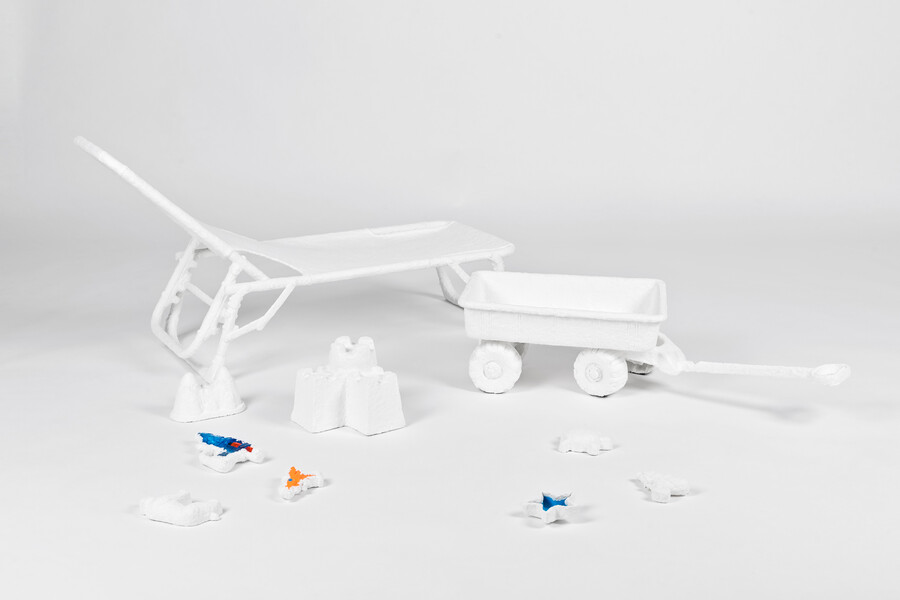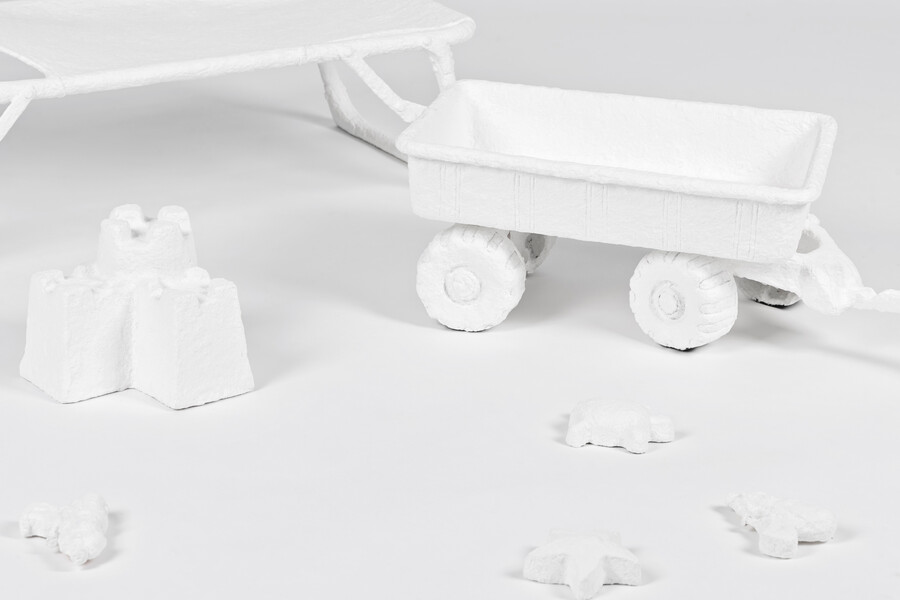
Hidden stories #7
31 July 2025
Uncovering our collection
Our collection continues to grow! In this blog, curator Suzan Rüsseler tells you more about the installation by Afghan-Dutch artist Narges Mohammadi, acquired in 2023, which gives her personal experiences as a refugee a greater dimension in her art.
The freedom to be a child
The kite that never flew is the poetic title of an installation by Afghan-Dutch artist Narges Mohammadi (born 1993). Various objects are visible beneath an ivory-coloured, paper-like layer with a fine relief. You can recognise beach items and toys: a small stretcher, a cart, sand buckets and moulds, and water pistols – all of them are covered in the same white-beige papier-mâché skin. Sometimes a small piece of brightly coloured plastic peeks through underneath. You might think of summer fun and long days at the beach, but the tranquil scene also has something oppressive about it. Time seems to stand still – no possibility of building sandcastles. The melancholic title triggers the imagination. Why did the kite in the title never fly? The answer to that question lies in the artist's life story.

Narges Mohammadi, 'The kite that never flew'(detail) 2023, photo by Josefina Eikenaar, collection TextielMuseum
Turning pain into art
Traditions, mourning and memories are important themes in the work of Narges Mohammadi. In “The kite that never flew” (2023), the artist depicts painful memories of her childhood and the loss of an innocent youth. At the age of nine, she fled with her family from the violence of war in Afghanistan and, upon arriving in the Netherlands, stayed in various asylum seekers' centres. The experience of her flight and growing up in uncertain circumstances as a refugee in the Netherlands has left deep scars.
In a film made for her solo exhibition in 2023/24 at Museum Beelden aan Zee, Mohammadi says that she tends to avoid the beach because of the unpleasant memories of her flight, leaving the country on a rickety boat. (1) Nevertheless, creating the installation proved to be a healing experience. It started with the pleasure of buying beach equipment that she herself never had. Together with others, she made the papier-mâché and coated the objects. The choice of papier-mâché, a hobby technique often practised by children, reinforces the element of play for the artist.
Papier-mâché is made from small pieces or strips of torn paper that are mixed with water and wallpaper paste to form a paste, which then hardens. Many people will remember making lanterns by covering a balloon with paper and wallpaper paste. Mohammadi, however, used torn strips of cotton with water and glue as the basis for her pulp. Like a blanket of mourning, the textile papier-mâché envelops the objects.
'The kite that never flew' the silent story in the collection
Mohammadi's installation “The kite that never flew” made an impression when I first saw it in 2023 at the Art Rotterdam art fair. From the large number of artworks that demanded attention, the tranquil scene of seemingly lost beach objects nestled in my memory. The work attracts the eye, yet at the same time it does not immediately reveal itself. However, the atmosphere it evokes and its title intuitively suggest that it is about something like an unfulfilled desire.
In addition to artworks and design, the TextielMuseum also collects as much as possible from the creative process. Mohammadi herself provides the various working groups of “The kite that never flew” with a printed set of A4 sheets and the research dossier she compiled on the economy and (illegal) industry underlying the trade in refugees – documents that the museum often displays in exhibitions.
Spotting talent
Studio visits, final exams and art fairs are just some of the possibilities in the search. I first saw Mohammadi during her final exam in 2020, for which she won the Young Blood Award. This was followed by the Charlotte Van Pallandt Prize and, in 2024, a few months after purchasing the Textile Museum, the Volkskrant Visual Arts Prize. The professional jury for that prize praised Mohammadi's work because it touches both the heart and the mind and makes it possible to empathise with how displacement leaves gaps in a person's life. (2)